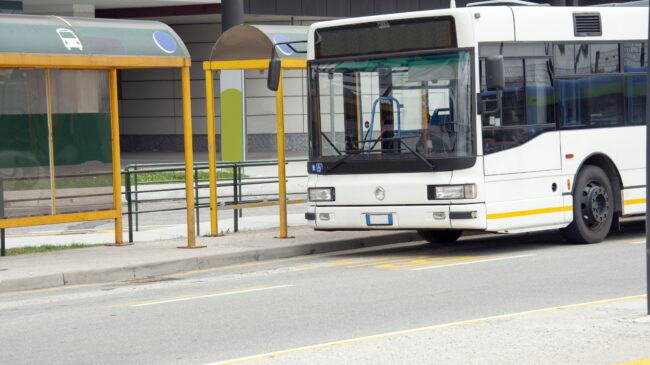Transportation Secretary Pete Buttigieg says one of his top priorities is addressing inequities such as “transit deserts,” particularly in communities of color. Buttigieg recently told Axios:
“A lot of people know about the idea of food deserts, where you can’t get access to fresh food. There are transit deserts —disproportionately in Black and brown neighborhoods, where people can’t get access to economic opportunity. Other times the reverse happened. Investment came, but it came in the worst possible fashion, like a highway dividing a thriving Black neighborhood. … [W]e have likely a once in a lifetime opportunity to make a generational investment. We’ve got to make sure … that it has a lot to do with racial equity in terms of where the dollars go.”
It is true that communities of color often have subpar mass transit service compared to wealthier, whiter neighborhoods. One solution is changing federal policy to incentivize bus service and to better utilize private complementary transit options that can help the underserved areas.
Currently, one of the reasons many mass transit agencies try to build rail transit systems is because they can often get at least 50% of the share of the project’s total costs from the federal government. Rail advocates tout this as “free money” and many local governments cannot resist feeding at the federal trough. One problem, however, is that rail also requires a local match and the funds to maintain and operate the system. And since most rail ridership numbers regularly come in below the projections, most systems cut bus service to shift money towards operating rail service. Many of these rail systems have also skimped on maintenance. While the New York and Washington subways have made the news in recent years with fires and service slowdowns plaguing the systems, the lack of maintenance of many of the newer light rail systems is also a ticking time bomb.
Communities of color are often lower-income and lower-income residents tend to use the bus far more frequently than rail. Less than 1% of commuters making less than $10,000 use rail use rail. Rail usage is lowest for riders earning $10,000 to $50,000 per year.
Data show that rail usage is the highest among riders earning $125,000 to $200,000 per year. In contrast, bus use is highest among riders who make less than $35,000 a year and it is lowest for those who make $75,000 or more a year. Almost 8% of commuters making less than $10,000 a year use buses. Meanwhile, less than 1% of commuters making $100,000 or more use buses.
Middle-class transit customers (those in the 3rd income quintile) use rail the least. The wealthiest commuters (those in the 5th quintile) use transit more than working-class customers (those in the 2nd quintile) and middle-class customers (those in the 3rd quintile).
Due to the COVID-19 pandemic, many metro areas have cut more than 50% of their transit service for the time being. But bus cuts were occurring long before COVID-19 hit the United States.
Going forward, Transportation Secretary Buttigieg cannot control state and local priorities or policies, but he can impact federal government policy tools and funding levels. Secretary Buttigieg could start by prioritizing maintenance over new construction. Deferred maintenance is a problem in most cities and states. Currently, transit capital projects can be matched at a rate as high as 80% while operating and maintenance projects can be matched at only 50%. Much of this funding is used to build new light rail projects, often at the expense of needed bus system maintenance and upgrades. These numbers should be reversed, with capital projects funded at 50% and operating projects at 80%.
Another change that Buttigieg and Congress should adopt is changing how transit projects are funded by making those decisions based on the project’s average cost to transport one rider on one trip. The primary justification for providing taxpayer funding to transit is supposed to be to help working-class residents reach jobs. But, unfortunately, some transit systems have built inefficient light rail lines that are both expensive and carry few passengers. Using the cost-per-trip metric would help reward transit agencies with high ridership and low costs, which should be a goal of any government program.
Another useful change would be to bring parity to bus funding and rail funding. The majority of funding in the Urbanized Area Formula Grants, State of Good Repair Grants, High-Intensity Fixed Guideway Program, and the general funded program supports rail. For State of Good Repair Grants, the rail formula program provides $2.4 billion in funds while the motorbus State of Good Repair Program provides a mere $71 million. Clearly, it costs more to maintain rail than buses, but buses comprise more than 95 percent of all the transit nationwide. Buses are also more cost-effective outside of all but a couple of the nation’s largest metro areas.
Finally, there are many routes in which private supplementary transit could play a role—everything from low ridership suburban routes where a fixed-route bus cannot be justified to high ridership urban routes where additional service is needed. The federal government could create a pilot program to encourage experimentation with new private transit options. The program could include a small pot of funding for projects such as Via on-demand transit, where riders can use an app to schedule pick-ups at what are effectively virtual bus stops.
Mass transit spending and service shouldn’t be obsessed with the allure of rail. It should focus on the effectiveness and ridership numbers that buses provide, especially to low-income workers.

